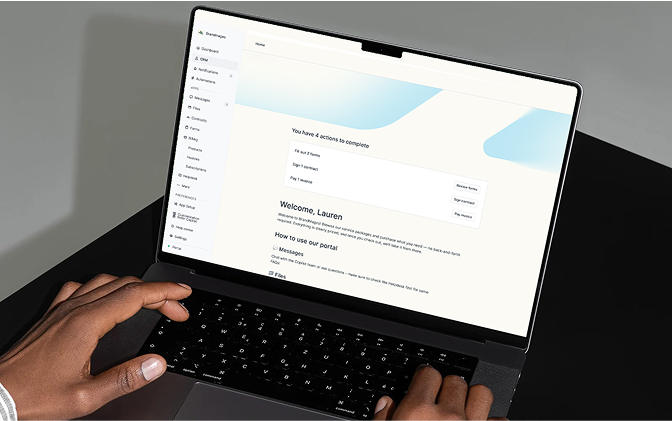
Better than Clinked
Running a service business? Upgrade to the highest-rated Clinked alternative today and elevate your client's experience.
4.9 rating
There are a ton of tools out there that help you spin up client portals and run your service business.
One of those is Clinked. And in this article, I’m going to give you my full review of the platform.
When I first came across Clinked, I wasn't sure how to think about it. On one hand, they have been around since 2008 and have some impressive clients. On the other hand, I wasn’t sure if it was modern enough to leverage in the age of AI.
So I decided to dig deeper. I explored their features, read through customer reviews, and tried to figure out exactly who this tool is built for.
What I came to realize is that Clinked is built for a very specific type of customer. And I’m going to explain who that is in the next section.
After that, we’ll go over what features you get with Clinked, how much it costs, and whether it's worth your money. I'll also share some alternatives if Clinked doesn't quite fit what you're looking for.
Who is Clinked for?

When you look at Clinked's customer roster, you'll see some pretty big names like Canon and Bacardi. So right off the bat, you can tell Clinked is built for the big guys.
Clinked seems to have carved out a niche serving larger enterprise companies, particularly those in traditional industries. They even have dedicated audience landing pages for accountants, insurance companies, financial advisors, and even employee portal software. Companies like Desjardins (a major Canadian financial services firm) also use them.
So what does this mean?
It means Clinked is built for businesses that prioritize stability, compliance, and traditional workflows over modern, flexible tech stacks. And that makes total sense for their target market.
But if you're running a modern, tech-forward agency, Clinked might feel a bit corporate.
I'm talking about marketing agencies that live and breathe in tools like Airtable and Figma. AI automation agencies that need deep API integrations. Design studios that want their portal to feel as polished as their work. Or those forward-thinking accounting firms that have ditched software that looks like it was designed in 1998 (that era had its charm, though).
For these types of businesses, Clinked can feel like wearing a suit to a startup job interview (which I actually did). It can work, but it doesn't quite fit the vibe.
If that sounds like you, you might want to explore Clinked alternatives that better align with how modern service businesses actually operate.
You'll love Clinked if:
- You're an enterprise with 100+ employees needing complex permission hierarchies
- Your industry requires strict compliance and audit trails
- You want everything contained in one platform rather than integrated tools
- Your clients expect a formal, corporate-feeling interface
- You need features like document approval workflows and employee intranets
You may not be a fan if:
- You're a small agency or freelancer who values simplicity
- You want to embed your existing tools (Airtable, Looker Studio, etc.)
- You're looking for modern, sleek UI/UX design
- Your budget is under $100/month
- You need deep API access for custom automations
Okay, now let’s look at some of the popular features of Clinked.
Clinked popular features
Let’s take a look at some of the widely used features of Clinked.
Client portal
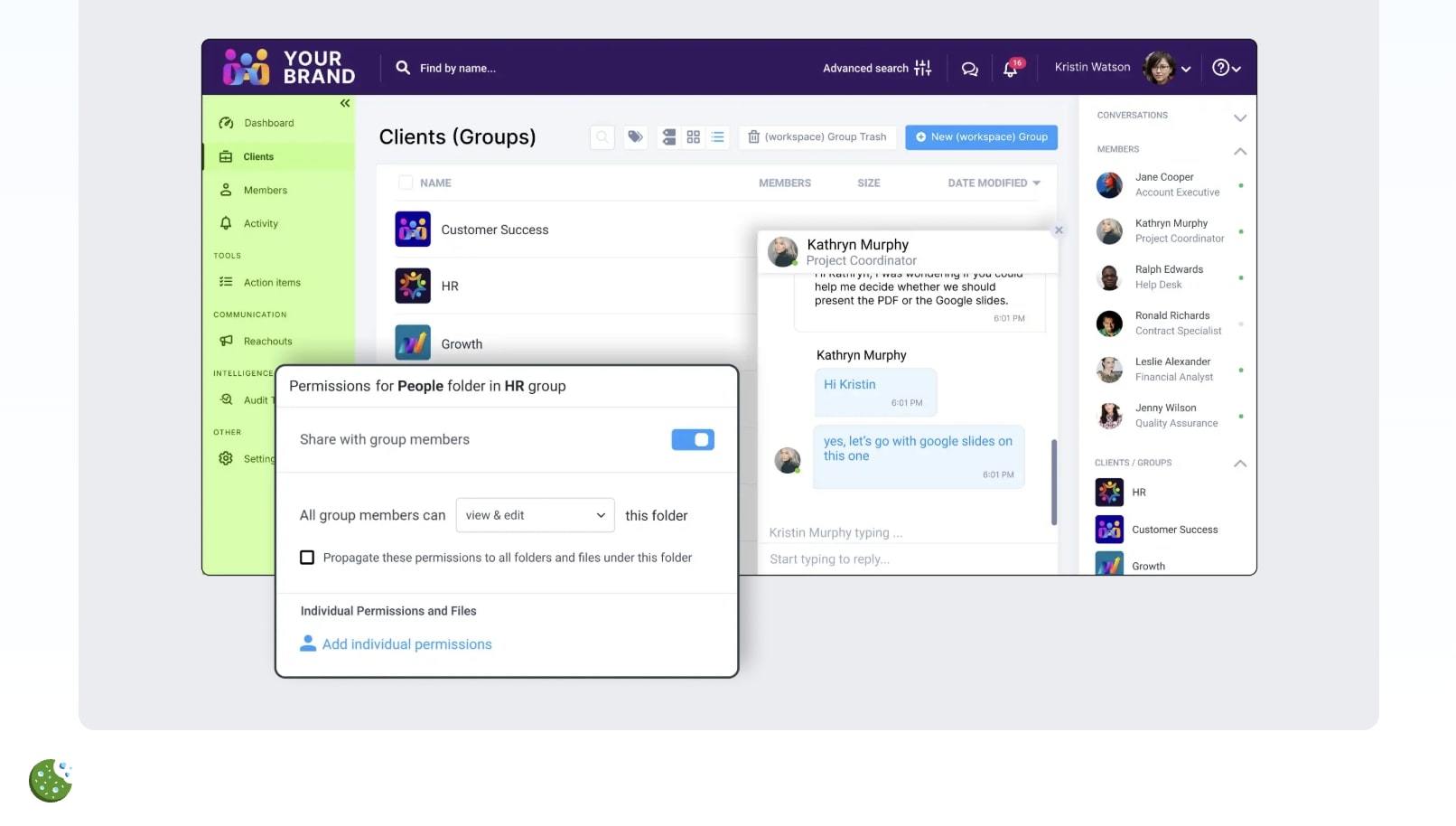
At the core of Clinked is the client portal feature. Here you can share files, manage tasks, and communicate with your clients in one place.
The custom portal options let you add your logo, adjust colors, and use your own custom domain. You can organize clients into groups, set permissions for who sees what, and track activity across your workspace.
What I found interesting is how Clinked approaches client management. They have built-in features like file approval workflows, @mention messaging, and the ability to duplicate entire group structures. There's even an Adobe Acrobat Sign integration for document signing and a file request feature that lets you collect files from people who aren't members of your portal.
The Zapier integration also gives you opportunities to automate certain tasks and connect Clinked with thousands of other apps. This could help fill some gaps if you're using other tools in your workflow.
For large enterprises managing complex client relationships across multiple departments, these features provide a lot of control and structure. The email notifications and activity streams help teams stay on top of changes across numerous client accounts.
One thing to consider is that Clinked's approach is very much about keeping everything within their platform rather than embedding your existing tools. If you're already invested in specific project management or reporting tools, you'll likely be using them alongside Clinked rather than within it.
Client onboarding
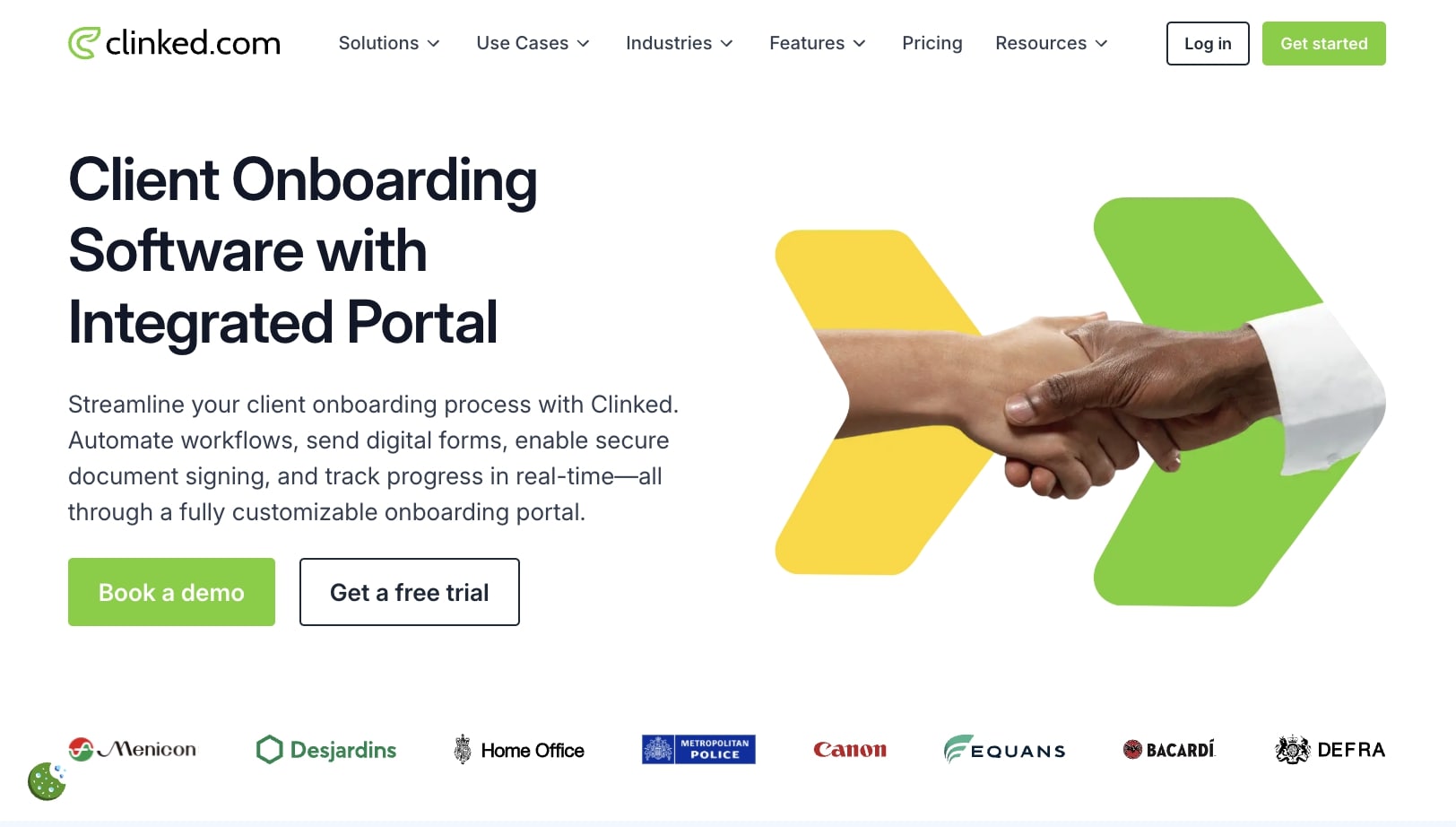
A big part of any client business is onboarding. This is the part you definitely don’t want to get wrong.
The good news is that Clinked's client onboarding software helps you automate the typical onboarding workflow that most service businesses deal with.
The platform gives you a few ways to handle onboarding:
- Data collection: Digital forms through native Jotform integration
- Document signing: Both Adobe Acrobat Sign and DocuSign integrations
- File management: Pull templates and documents from OneDrive or Google Drive
- Progress tracking: See where each client is in the onboarding journey
- Tool embedding: Use iframes to embed your existing onboarding tools
- Automation: Connect to other apps through Zapier
The white-label features also mean new clients see your branding from day one. You can customize the portal with your logo, colors, and domain, which helps maintain that professional appearance during those crucial first interactions.
Communication during onboarding happens through their multi-channel system. You can chat one-on-one with clients, send group messages, or make company-wide announcements. The ability to tag and comment on files, events, and tasks helps keep everyone on the same page about what needs to happen next.
For larger companies with standardized onboarding processes, this setup gives you a fairly good structure and sense of control. You can create templates, automate repetitive tasks, and make sure nothing falls through the cracks.
However, if you're used to more modern onboarding experiences that feel closer to a SaaS product signup flow, Clinked's approach might feel more traditional. It's built for businesses that need detailed documentation and approval chains rather than quick, self-serve onboarding.
Employee intranet
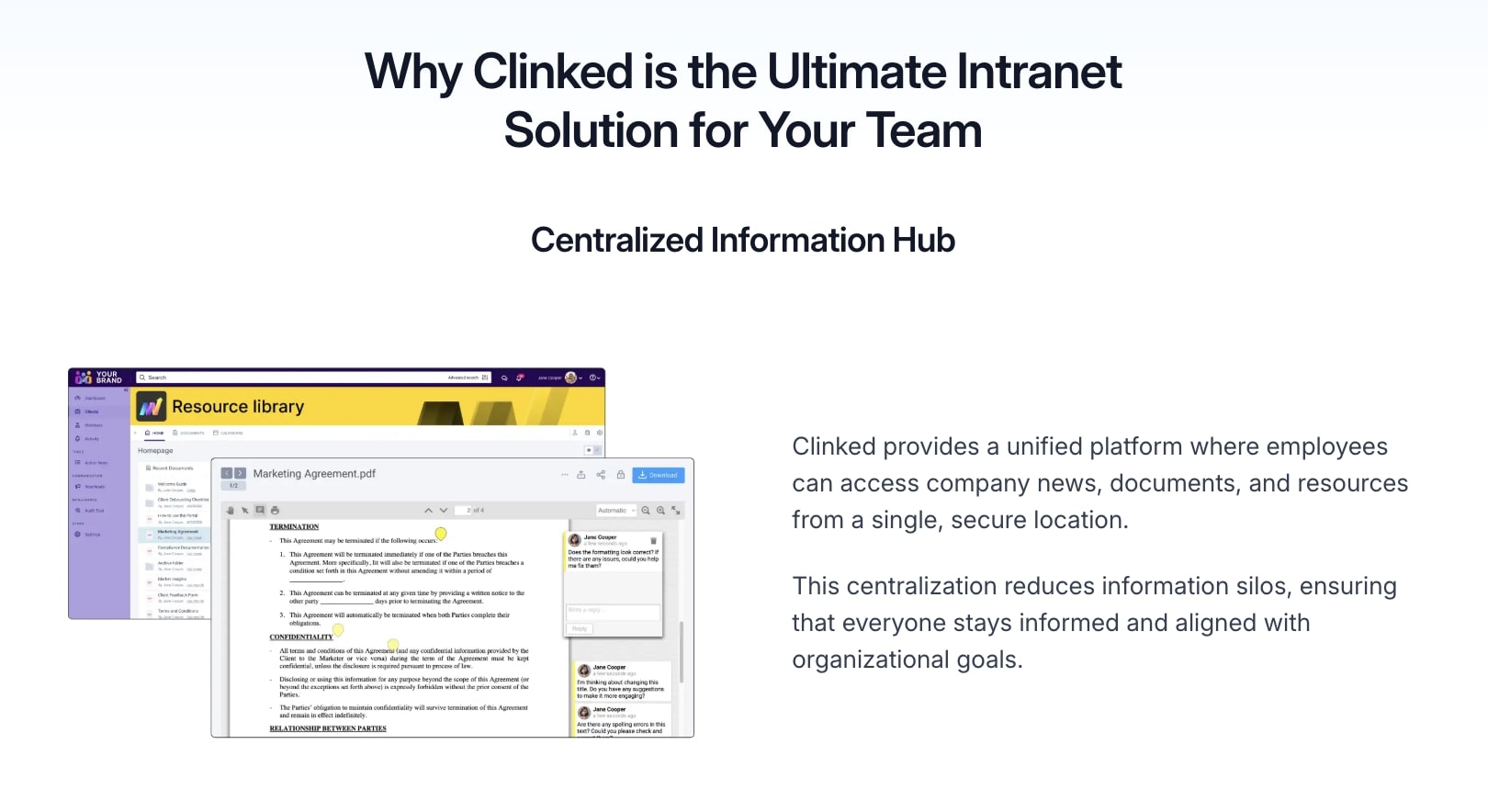
Given that we have talked a lot about how Clinked serves larger corporate companies, it only makes sense that they have an employee intranet feature.
This is where Clinked really shows its enterprise roots. The intranet functionality lets you create internal workspaces for your team, separate from client-facing portals. You can also set up department-specific areas, share company policies, post announcements, and manage internal projects.
The features you'd expect from an intranet are all there:
- Company directory: Employee profiles and contact information
- Document libraries: Centralized storage for policies, procedures, and templates
- News and announcements: Company-wide updates and department news
- Internal forums: Discussion boards for team collaboration
- Task management: Assign and track internal projects
- Permission controls: Different access levels for different teams or roles
The same white-label options apply here, so your internal portal matches your brand. Employees can access it through web browsers or the mobile app, which is helpful for teams that aren't always at their desks.
For companies that need both client portals and employee intranets, having both in one platform makes sense. You're not managing two separate systems, and your team only needs to learn one interface.
But if you don't have a ton of employees, then this feature can be a bit much. You're likely already using Slack or Microsoft Teams for internal communication, and that might be good enough.
This feature only really shines for organizations with 50+ employees who need structured internal communication channels and want to reduce their reliance on email for company updates.
How much does Clinked cost?
Okay, let’s talk costs. Clinked has a lot of different plans. The entry-level plan is fairly affordable, but it can get expensive as you scale your client base.
Clinked pricing plans
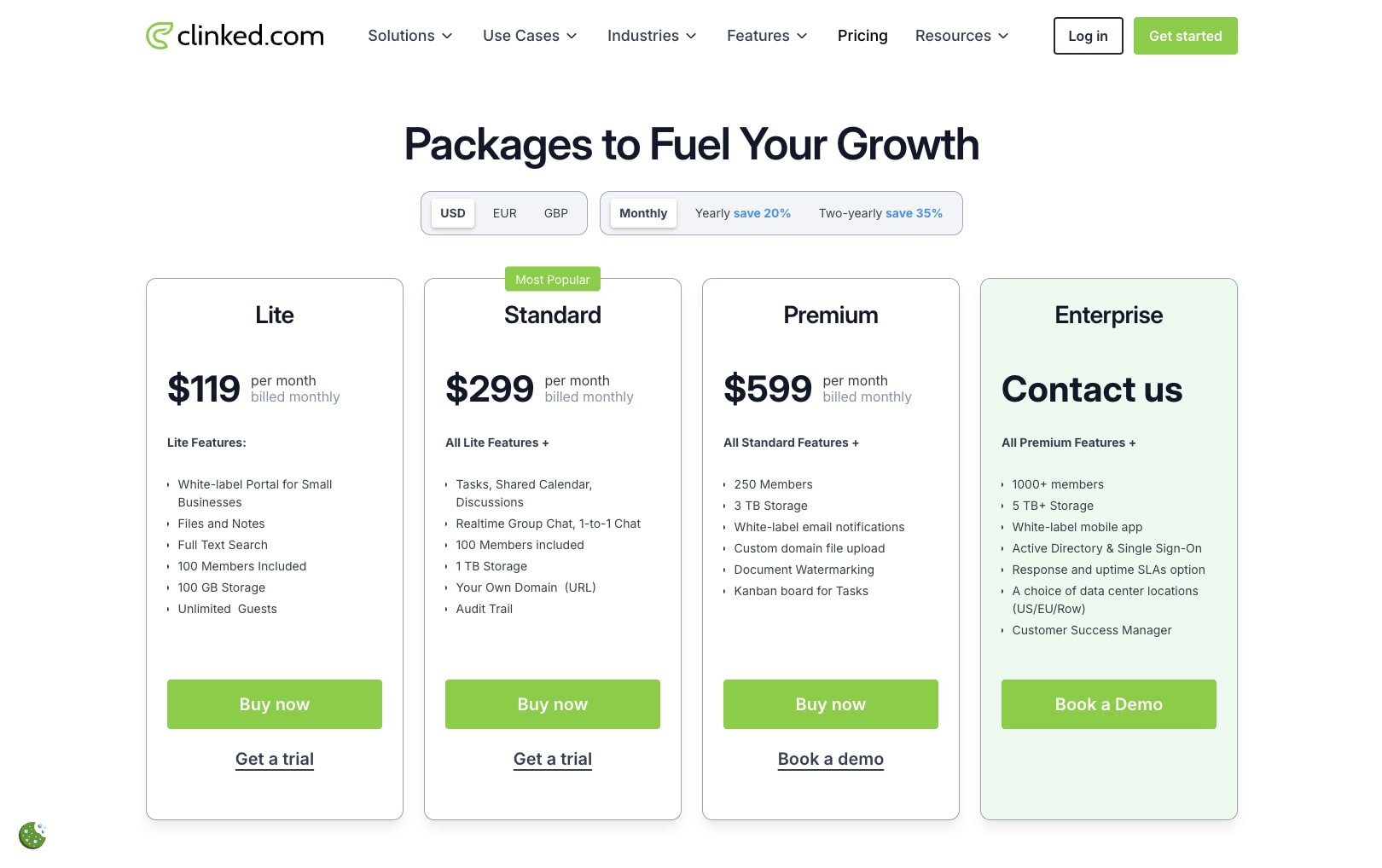
Here are Clinked’s pricing tiers:
- Lite: $119/month. Comes with 100 members, 100GB storage, unlimited guests, white-label portal, files and notes
- Standard: $299/month. Comes with 100 members, 1TB storage, unlimited guests, custom domain, tasks, calendar, chat, audit trail
- Premium: $599/month. Comes with 250 members, 3TB storage, unlimited guests, white-label emails, document watermarking, Kanban boards
- Enterprise: Custom pricing. 1000+ members, 5TB+ storage, white-label mobile app, SSO, dedicated Customer Success Manager
Right off the bat, these prices are significantly higher than most client portal tools on the market. The Lite plan at $119/month is what many competitors charge for their premium tiers.
The Lite plan gives you 100 members (which includes both your team and clients), but you only get 100GB of storage. For a tool that's supposedly built for file sharing and collaboration, that's not a lot of space. You also miss out on basic features like tasks and calendars at this tier, which feels limiting.
The Standard plan at $299/month is where Clinked becomes functional for most businesses. You get tasks, calendars, chat, and your own custom domain. The jump to 1TB storage is welcome, but you're paying nearly $300/month for features that many other tools include in their basic plans.
What I do appreciate is that all plans include unlimited guests. So if you need to occasionally share something with someone outside your regular client base, you won't get charged extra.
The pricing structure clearly targets larger organizations with bigger budgets. If you're a small agency or freelancer, these prices might be hard to justify unless you absolutely need the enterprise-level features.
You can save 20% with yearly billing or 35% with two-year commitments, but that's still a significant upfront investment.
For the most detailed breakdown of what's included in each plan, check out their pricing page.
Clinked customer support
Customer support is always something I like to look at when reviewing tools. For a tool like Clinked, where the customers are larger organizations, it only makes sense to have amazing support.
And from what I can tell, they deliver on this front. Clinked has a 4.9/5 star rating on G2, with customers consistently praising their support team. One reviewer mentioned that the support team is "quick to respond to private cases" and "diligent about finding answers and coaching my team through issues we may encounter."
Another customer noted that even when they run into problems, "the customer support team is very responsive and usually provides a fix that will solve our problem." This kind of responsive support is exactly what I always look for in software tools.
Clinked also offers several ways to get help. You can book a demo to get a walkthrough of the platform, check out their FAQ section for quick answers, or browse their video tutorials to learn specific features.
For Enterprise customers, they mention having a dedicated Customer Success Manager, which makes sense given the price point and complexity of larger implementations. The fact that customers are happy enough to leave reviews about support specifically tells you that there’s truth to it.
Clinked scalability (and security)
Based on everything we've covered so far, Clinked is clearly built to scale for larger organizations. Their Enterprise plan supports 1000+ members and 5TB+ of storage, with the ability to expand beyond that. The fact that they offer features like Active Directory integration and SSO (Single Sign-On) shows they're thinking about companies that need to manage hundreds or thousands of users.
The platform can handle complex organizational structures with nested groups, detailed permission hierarchies, and multiple workspaces. You can have separate areas for different departments, regions, or client segments, all managed from a central admin panel. For growing companies, the ability to duplicate entire group structures means you can quickly spin up new client workspaces without starting from scratch.
When it comes to security and compliance, Clinked also seems to take it seriously (as they should for their enterprise client base).
They have the certifications to back it up:
- Encryption: 256-bit SSL for data in transit and AES encryption for data at rest
- ISO 27001: Bank-grade security management systems
- Compliance standards: SAS70, PCI, and GDPR compliant
- UK certifications: G-Cloud member and Cyber Essentials Certified
- US standards: HIPAA, FISMA, and FIPS compliance through AWS
For companies in regulated industries like healthcare or finance, these certifications matter. You can't just store client data anywhere, and Clinked has done the work to meet these strict requirements.
They also offer the option to choose your data center location (US, EU, or Rest of World), which is important for companies dealing with data residency requirements. The audit trail feature means you can track every action taken in the portal, which is really important for compliance and accountability.
If security and scalability are your top priorities, Clinked has clearly invested in the infrastructure to support enterprise-level needs. Just remember that all these enterprise features come with enterprise pricing to match.
Clinked pros and cons
After spending some time with Clinked, here’s my honest take on what we like and what we think could improve.
Clinked pros
Here are some of the pros of using Clinked:
- Solid security certifications (ISO 27001, HIPAA, GDPR)
- Responsive customer support
- Unlimited guest users on all plans
- White-label and custom domain options
- Established platform (around since 2012)
Clinked cons
Here are some potential cons of using Clinked:
- Has a high starting price point
- Limited storage on lower tiers
- UI feels more corporate intranet than modern web app
- Overkill for small teams
- Learning curve is steep and can take time to set up and train your team
Final thoughts
Overall, if you're an enterprise-level company with a ton of employees, Clinked is a great option to look into. With companies like Canon and Bacardi as customers, the platform is clearly built for scale and security.
If you have a thousand employees and need complex permission hierarchies, dedicated support, and enterprise-grade compliance certifications, this is a tool worth exploring.
However, if you're looking for something more lightweight, something that's better designed for freelancers and tech-savvy agencies, it might be worth looking into an alternative like Assembly.
The client portal space has room for different approaches. Some businesses need the enterprise features and are willing to pay enterprise prices. Others want something modern, flexible, and affordable that can grow with them.
At Assembly, we built our platform for that second group. We wanted to create something that works whether you're a freelancer just starting out or an agency with 50 employees. From payments to contracts, everything lives in one place, and you can actually embed the tools you already use rather than replacing them.
The right client portal depends on where you are today and where you're headed tomorrow. Clinked has carved out its enterprise niche well. But if that doesn't describe your business, there are other options out there that might be a better fit.
Whatever you choose, make sure it's something you and your clients will actually want to use. Because the tools you decide to use should always serve your clients and customers.
Your clients deserve better.
Try for free for 14 days, no credit card required.
